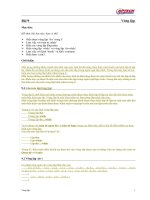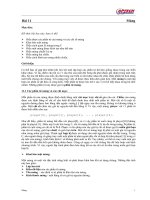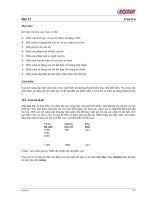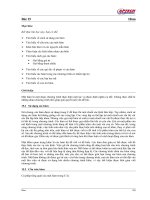Computer concept 2018 module06
Bạn đang xem bản rút gọn của tài liệu. Xem và tải ngay bản đầy đủ của tài liệu tại đây (3.58 MB, 132 trang )
Computer Concepts 2018
Module 6
Software
Copyright © 2019 Cengage. All rights reserved.
Module Contents
•
•
•
•
•
Section A: Software Basics
Section B: Operating Systems
Section C: Apps and Applications
Section D: Productivity Software
Section E: File Management Utilities
© 2019 Cengage. All rights reserved.
Section A: Software Basics
•
•
•
•
Essentials
Distribution
Software Licenses
Fake and Pirated Software
© 2019 Cengage. All rights reserved.
Section A: Objectives (1 of 2)
•
Draw a hierarchical diagram that illustrates the three main categories of software and their
subcategories
•
•
•
•
•
State four best practices for obtaining software
Distinguish between software updates and upgrades
List four pricing models commonly used in the software industry
Explain why most software is licensed
Describe the difference between proprietary software and public domain software
© 2019 Cengage. All rights reserved.
Section A: Objectives (2 of 2)
•
•
•
•
List and describe three types of commercial software licenses
Create a chart comparing freeware, demoware, and shareware
Name two popular open source software licenses
List four ways to avoid fake mobile apps
© 2019 Cengage. All rights reserved.
Essentials (1 of 7)
•
•
When searching for new software, it helps to have a framework of categories
System Software
–
Operating Systems
–
Windows, macOS, iOS, Linux, Android, UNIX, and Chrome OS.
Device Drivers
–
For controlling a digital device’s internal operations
For digital devices to communicate with each other .
Printer Drivers and Video Drivers
Utilities
For file management, security, communications, backup, network management, and system monitoring
© 2019 Cengage. All rights reserved.
Essentials (2 of 7)
•
Development Software
–
Programming Languages
–
For writing programs C Basic, Java, Fortran, C++, C#, Scheme, and Objective-C
Scripting Languages
–
For writing scripts, creating Web pages, and querying databases
HTML, JavaScript, PHP, Python, Ruby, and SQL
Quality Assurance Tools
For testing software Debuggers, Load Testing, Security Testing
© 2019 Cengage. All rights reserved.
Essentials (3 of 7)
•
Application Software
–
Professional Tools
–
Desktop Publishing, Graphic Design, and Special Effects
Educational Software
–
For automating professional activities at work and in the home office
For students and teachers engaged in the process of learning in classrooms and at a distance
Tutorials, Courseware, and Learning Management Systems
Personal Finance Software
For managing bank accounts, preparing taxes, retirement planning, and other financial matters
Tax Preparation, Banking Apps, and Loan Calculators
© 2019 Cengage. All rights reserved.
Essentials (4 of 7)
–
Entertainment Software
–
Ebook Readers, Games, Media Players, and Media Editors
Reference Software
–
For accessing media and playing games
For accessing information in specific topic areas
Travel, Sports, Medical, Hobbies, Lifestyle, Maps, News, Weather, and Shopping
Social Media Software
For accessing and working with social media services, such as Facebook and WordPress
Social Analytics, Dashboards, and Marketing
© 2019 Cengage. All rights reserved.
Essentials (5 of 7)
–
Business Software
For automating core business functions
Accounting, Inventory Management, Billing Databases, Point of Sale, Sales force Management and
Estimating
–
Productivity Software
For automating tasks formerly carried out with legacy technologies, such as pen and paper,
typewriters, calculators, and slide Projectors
Word Processors, Spreadsheets, Presentations, Calendars, and Contact Managers
© 2019 Cengage. All rights reserved.
Essentials (6 of 7)
•
There is no universal standard for
categorizing software, but various
categorization schemes have many
similarities
© 2019 Cengage. All rights reserved.
Essentials (7 of 7)
•
Mobile devices are used differently from
desktop and laptop computers, so the
configuration of their software is slightly
different
•
Files tend to be stored and retrieved by
each app, so users have little need for a
utility that allows access to the file
management system.
© 2019 Cengage. All rights reserved.
Distribution (1 of 5)
•
Most consumers obtain software online, where it can be downloaded directly from the developer
or from a software aggregator
•
An executable file contains a computer program that is carried out step-by-step within the
microprocessor
•
Software can contain viruses and other malware, so consumers should download new
applications only from trusted sources
•
Software developers usually have a Web site for distributing software. Well-established
developers tend to offer trustworthy products
© 2019 Cengage. All rights reserved.
Distribution (2 of 5)
•
System requirements specify the operating system and minimum hardware capacities
necessary for a software product to work correctly
© 2019 Cengage. All rights reserved.
Distribution (3 of 5)
•
•
•
•
When a new version or edition of a software product is released, it is referred to as a software
upgrade
A software update (sometimes called a software patch) is a small section of program code that
replaces part of the software currently installed
The term service pack, which usually applies to operating system updates, refers to a set of
updates
Updates and service packs are designed to correct problems and address security vulnerabilities
© 2019 Cengage. All rights reserved.
Distribution (4 of 5)
•
Software can be obtained under a variety of pricing models
–
–
One-time purchase – the software remains basically the same as when it was purchased
Subscription – consumers pay a monthly or an annual fee to use software; updates and upgrades
are usually included in the pricing
–
–
Trial – consumers use a software product during a free trial period
Freemium – provides free use of a stripped-down or basic version of the product but requires
payment for upgraded features
© 2019 Cengage. All rights reserved.
Distribution (5 of 5)
© 2019 Cengage. All rights reserved.
Software Licenses (1 of 9)
•
A software license, or license agreement, is a legal contract that defines the ways in which a
computer program may be used
•
These licenses are sometimes referred to as EULAs (End User License Agreements)
© 2019 Cengage. All rights reserved.
Software Licenses (2 of 9)
•
License agreements are
displayed during the installation
process. By clicking the I Agree
button, you consent to the terms
of the license agreement
© 2019 Cengage. All rights reserved.
Software Licenses (3 of 9)
•
Public domain software is not protected by copyright because the copyright has expired or the
author has placed the program in the public domain, making it available without restriction
•
Proprietary software has restrictions on its use that are delineated by copyright, patents, or
license agreements
•
Commercial software is usually sold in retail stores or on Web sites. Most commercial software
is distributed under a single-user license that limits use to one person at a time
© 2019 Cengage. All rights reserved.
Software Licenses (4 of 9)
•
A site license is generally priced at a flat rate and allows software to be used on all computers at
a specific location
•
A multiple-user license is priced per copy and allows the allocated number of copies to be used
simultaneously
© 2019 Cengage. All rights reserved.
Software Licenses (5 of 9)
•
•
•
Freeware is copyrighted software that—as you might expect—is available for free. It is fully
functional and requires no payment for its use
Demoware is proprietary software made available as a trial version. It is distributed for free and
often comes preinstalled on new devices
Product activation is a means of protecting software from illegal copying by requiring users to
enter a product key or an activation code
© 2019 Cengage. All rights reserved.
Software Licenses (6 of 9)
•
•
A hash value is a unique number derived from encoding one or more data sets, such as names,
serial numbers, and validation codes
Shareware is copyrighted software marketed under a try-before-you-buy policy. It was conceived
as a low-cost marketing and distribution channel for independent programmers
© 2019 Cengage. All rights reserved.
Software Licenses (7 of 9)
•
Open source software makes uncompiled program instructions—the source code—available to
programmers who want to modify and improve the software. Linux is an example of open source
software
•
Two of the most common open source and free software licenses are BSD and GPL
© 2019 Cengage. All rights reserved.
Software Licenses (8 of 9)
•
The BSD license originated as the Berkeley Software Distribution license for a server operating
system
•
The GPL (General Public License) was developed for a free operating system called GNU. It is
slightly more restrictive than the BSD license because it requires derivative works to be licensed
© 2019 Cengage. All rights reserved.









